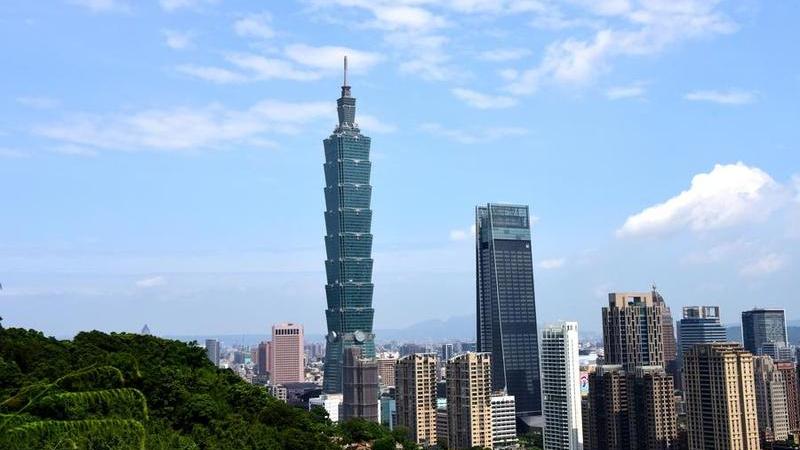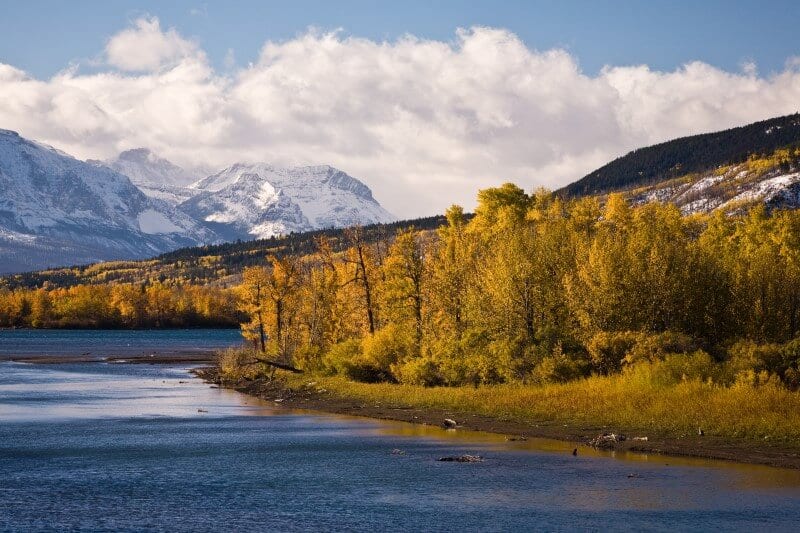
This post may contain affiliate links. We may receive a small commission, at no cost to you, if you make a purchase. Read Disclosure.
Fall is our favorite season of all – the Fall foliage colors, in brilliant shades of gold and red, the last glimpses of wildlife before they go into hibernation, and the crisp air that’s cool makes this state the perfect destination for hiking.
Fall is a great time to get outdoors and appreciate nature. Known for its rocky mountain ranges, rolling countryside and vast plains, fragrant pine forests and low-lying valleys abundant with rivers and lakes – there are plenty of hikes to do in Montana in the Fall that get you out enjoying the outdoors and close to the wildlife.
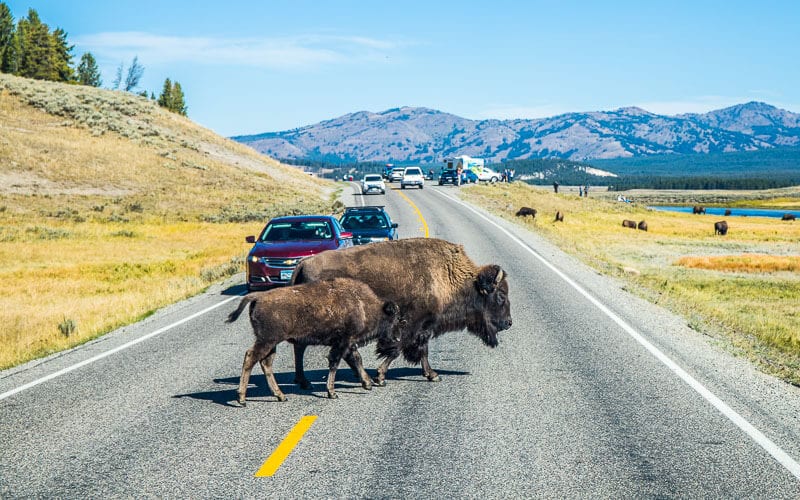 Yellowstone National Park
Yellowstone National Park
The cooler temperatures make for more pleasant hikes. The summer crowds have thinned out and the animals start moving to lower elevations, which is great for wildlife viewing.
Best Hikes In Montana In The Fall
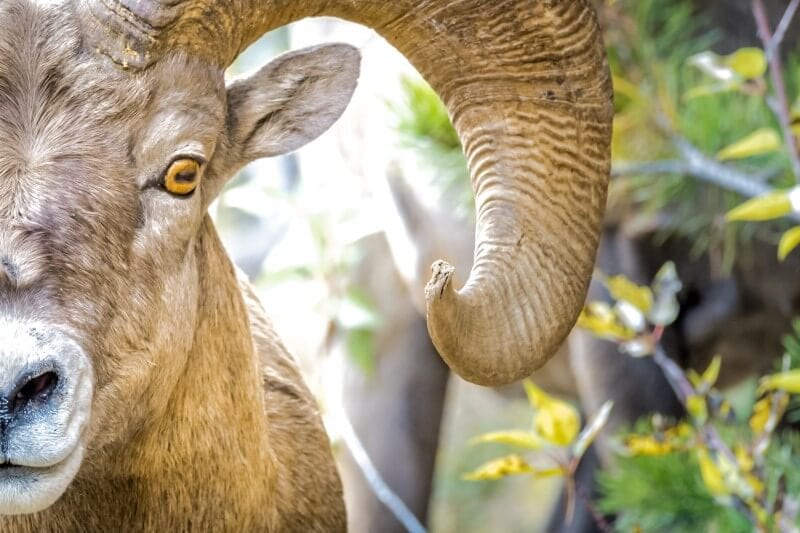
Montana has a greater variety of native wildlife than anywhere else in the lower 48.
From bison to mountain goats, grizzlies to wolves, wildlife viewing in Montana is abundant and spectacular, especially in the national parks and wildlife refuges.
Here are the best hikes to view them.
Yellowstone National Park, MT
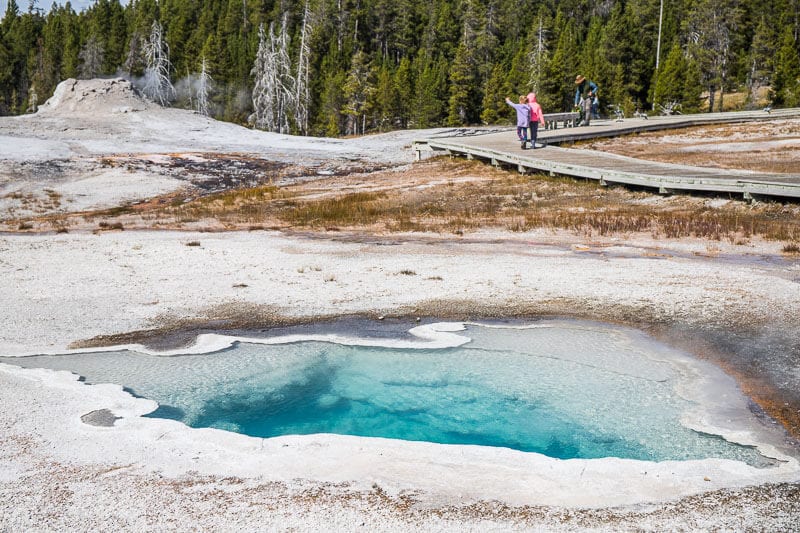
Is there a National Park more iconic than America’s first national park?
While most of Yellowstone National Park is located in Wyoming, parts of it also extend across the border into Montana, where there are three park entrances.
Yellowstone has more than 900 miles of hiking trails, ranging from short and easy day hikes to challenging multi-day treks.
Within the Montana side of Yellowstone, you can see geysers, colorful hot springs, bubbling mud pots, multiple rivers, and the Grand Canyon of the Yellowstone.
And, of course, lots of wildlife.
Here are some popular hikes to do in the Montana section of Yellowstone:
Beaver Ponds Loop, Mammoth Hot Springs
 Mammoth Hot Springs
Mammoth Hot Springs
You might be expecting to see beavers on this 9km loop hike across the Wyoming/Montana border, but they aren’t the only furry friend that calls this national park home.
This hiking trail is known for its bear activity, so be on the lookout, and come prepared.
I’ll admit, I am scared of grizzly bears, but it gives me great comfort to know many people hike the trail without any trouble and there are lots of bear safety tips out there.

The trail begins at the lower Mammoth Terraces next to the Mammoth Hot Springs Area. It then starts with a grueling 350 ft. climb up the hill.
The Beaver Ponds Loop hike then passes unique ponds nestled in the forest and open sagebrush meadows with expansive views down to Yellowstone River surrounded by cottonwood trees.
It’s an area known for elk, mule deer, pronghorn antelope, moose, beavers, and waterfowl.
Being a loop walk means the scenery and surprises will be different on the entire hike. I know loop walks motivate our girls more than a return one.
This Yellowstone hike is of moderate difficulty with an elevation gain of 231 meters and takes roughly 2.5 hours to complete.
The recommendation is to start at the Mammoth Terraces in Wyoming so you have a shorter uphill section, but this entrance is only a short drive over the border down Sun Road.
Yellowstone Llama Trekking the Daily Creek Trail
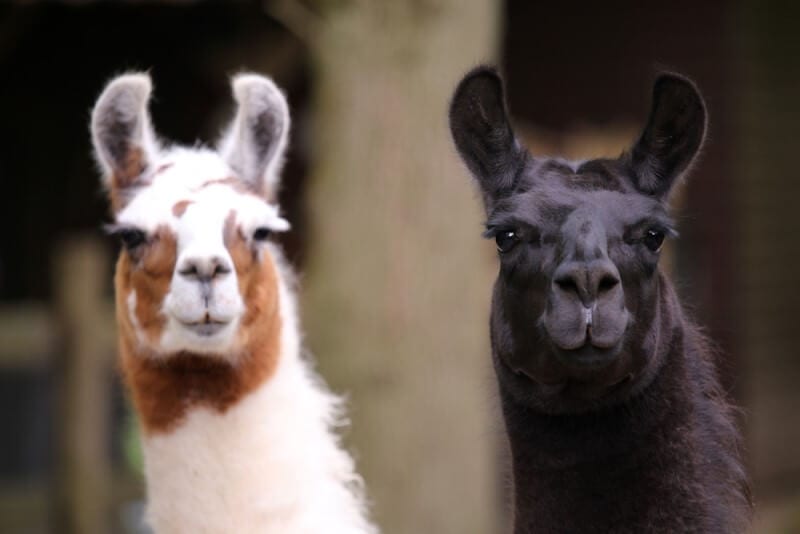
Looking for a unique hiking experience in Yellowstone National Park? Let a llama lead your way.
Your gentle, long-eared hiking buddy will walk with you on beautiful trails while carrying your load.
Experienced guides will help you explore Yellowstone backcountry, teach you about the park’s ecosystem, and help you find wildlife in their natural habitat.
Yellowstone Llamas offers multi-day backcountry pack trips in Yellowstone National Park with knowledgeable guides and gentle, well-trained llamas.
There are two trails they regularly do, but the Montana trail of choice is the Dailey Creek Trail, a 17km out and back trail near Big Sky, which is considered a challenging hike. But with a llama hiking with you holding your bag, the trail feels much easier.
Enjoy hiking, camping, wildlife watching, fly-fishing and good food. Treks are suitable for families and young children as well as groups of adults.
Glacier National Park

The scenery in Glacier National Park is said to dissolve your stresses and cares in an instant.
In the Fall, Autumn leaves burst with Fall colors of yellows, oranges and reds, complementing the epic mountain scenery.
Glacier NP is the headwaters for streams that flow to the Pacific Ocean, the Gulf of Mexico and to Hudson’s Bay, making it the Crown of the Continent, a precious and important national park.
It’s a huge national park that stretches over into Canada and includes 762 lakes, 563 streams, 175 mountains, over 700 miles of hiking trails and 26 active glaciers.
This is Big Sky Country after all!
Grinnell Glacier Trail
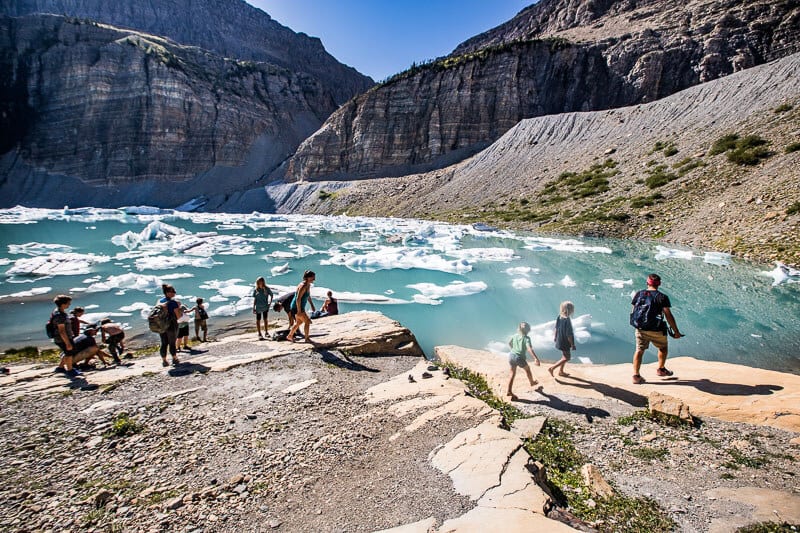
The Grinnell Glacier hike is known to be one of the most beautiful hikes in the world because it showcases everything that makes Glacier NP epic. It was one of our favorite things to do in Glacier National Park.
I’m talking about lakes, waterfalls, forests, alpine views, and the park’s most iconic glacier, Grinnell Lake.
This is a 10.6-mile (16.1 km) hike out and back trail from the trailhead near Siyeh Bend, Montana, but it can be reduced to about 7 miles with a concession boat ride from Many Glacier Hotel (fee required and reservations recommended.)
The hike follows the shores of Swiftcurrent Lake and Lake Josephine and elevates for 624 meters, offering you to breathtaking views of the Angel Wing mountain peak, the Garden Wall of the Continental Divide, and Grinnell Lake.
The stunning aqua-blue water of Upper Grinnell Lake is a sight to behold with the receding glaciers along the mountains surrounding the lake.
What a way to finish a climb up.
Be sure to stop for a while and savor the reward. If you leave early enough, you’ll get there before the crowds.
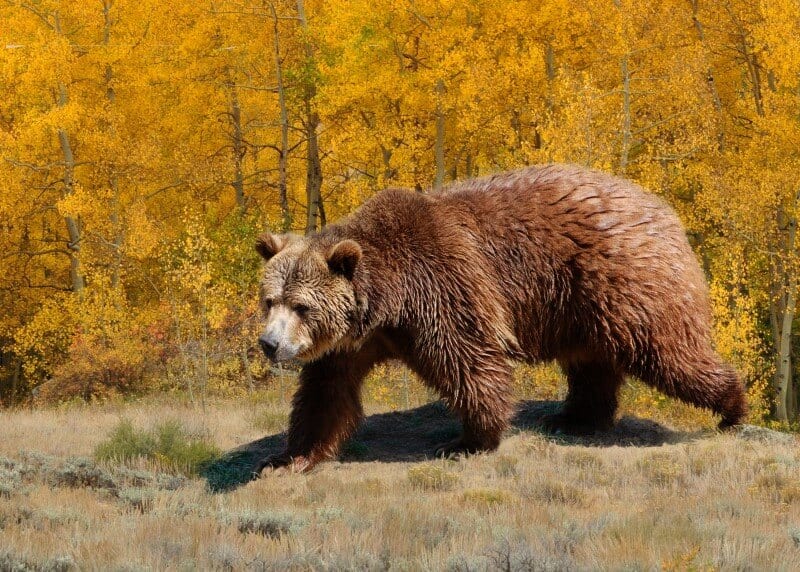
Look out for bighorn sheep, deer, mountain goats and bears along the trail. Be sure to take bear spray and proper hiking supplies.
Depending on fitness, the trail is moderately difficult. It is strenuous due to its length and an elevation gain, and it usually takes people on average 5 hours to complete.
Cracker Lake
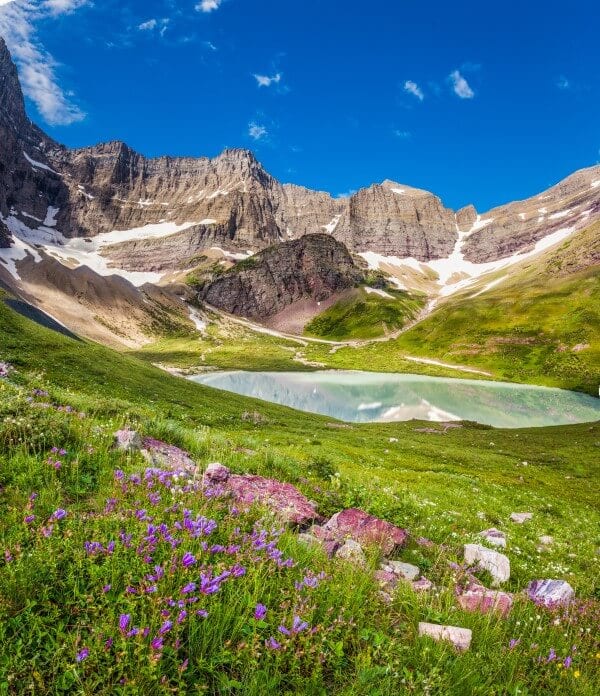
Cracker Lake is one of the most beautiful lakes in the world and one of the best hikes in Glacier National Park.
This beautiful turquoise-colored glacial lake is surrounded by a natural cathedral of towering walls and peaks.
One feature is the great North Face of Mount Siyeh towering over Cracker Lake in Glacier National Park. This giant wall is one of the tallest in North America, and it has only been climbed once.
The popular Glacier Park hike to Cracker Lake is over 20.6 km roundtrip with a 522 meter vertical gain in elevation. It usually takes 5.5 hours to complete.
It includes wooded forests, grand views of lakes and mountains, creek crossings, distant waterfalls, mining ruins, possible wildflowers and wildlife, and unrivaled views of the lake.
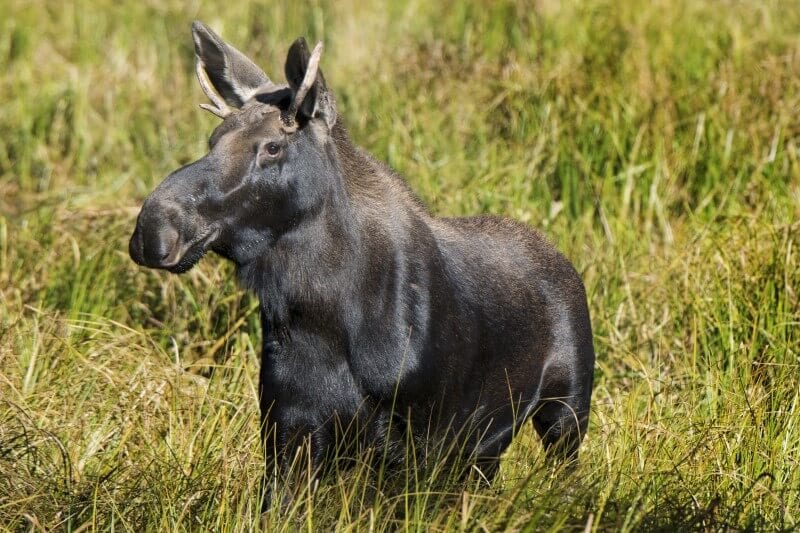 Credit: Glacier NPS
Credit: Glacier NPS
There have been moose sightings at the lake, and marmots (large squirrels) live around the campsite.
Mountain goats frequent this area—it’s also bear country, so put your singing voices on and make a bit of noise.
Lake McDonald West Shore Trail

Another popular trail in Glacier NP is the Lake McDonal trail along the west shores of the lake.
This 22.2-km out-and-back trail is a reasonably moderate hike that’s great for bird watchers and horseback riders.
You can take a detour to Rocky Point, but since it’s already a 5 hour hike, this would be only something we’d recommend to the serious hiker.
The trail begins from Fish Creek Campground, and follows the shores of McDonald Lake. You can also do a scenic drive around Lake McDonald on the Going-to-the-Sun Road, if you prefer the look of one of the other hikes for Glacier NP over this one.
National Bison Range Grassland Loop
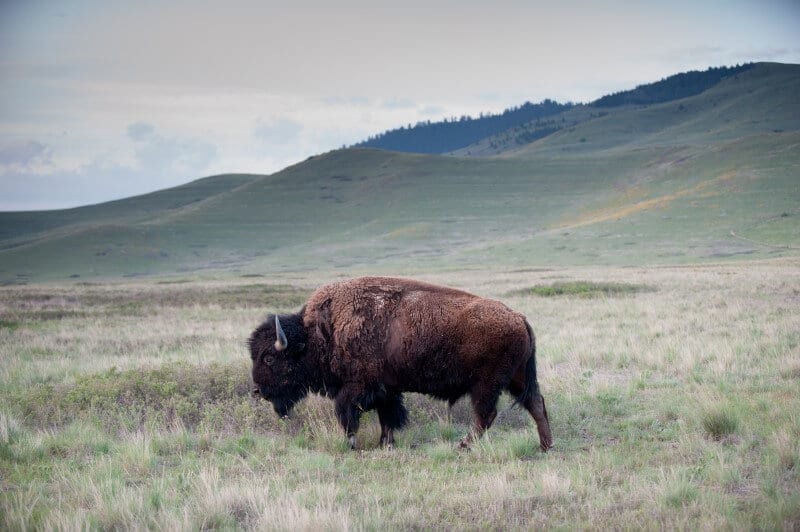
You cannot visit Montana without going bison watching. The Great Plains were once home to 60 million bison. It hurts my heart to know that now Montana is one of the last places where bison live in much fewer numbers.
They’re mostly found in Yellowstone National Park and at the National Bison Range in Montana.
The National Bison Range is one of the oldest wildlife refuges in the country. President Theodore Roosevelt established the National Bison Range in 1908 to provide a permanent home for bison.
The 18,500-acre range home to about 300-400 bison.
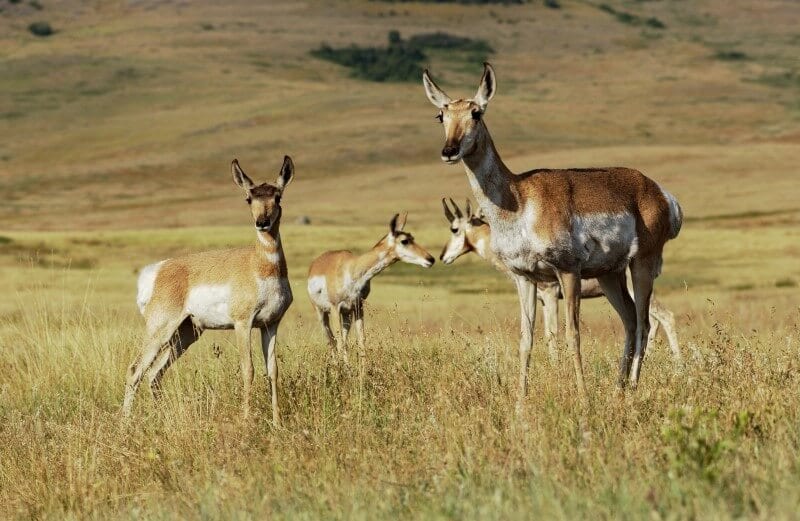 Credit: Visit Montana
Credit: Visit Montana
Because of its open grasslands, the Bison Range is a perfect place for the public to enjoy some excellent wildlife observation and photography.
By the National Bison Range Visitor Center, there is a short, easy 600 meter circular walk around the grasslands which gives you multiple viewing areas to observe the bison.
Other large wildlife found on the Range include elk, white-tail and mule deer, pronghorn antelope, bighorn sheep, black bear, coyote and ground squirrels.
Over 200 species of birds also call this home including golden eagles, hawks, meadowlarks, bluebirds, ducks and geese.
The National Bison Range is only about an hour drive from Missoula.
Big Sky Safaris offers guided tours of National Bison Range and the nearby area with a local nature guide. It’s most cost-effective for groups of 5-10 people.
Wild Horse Island State Park
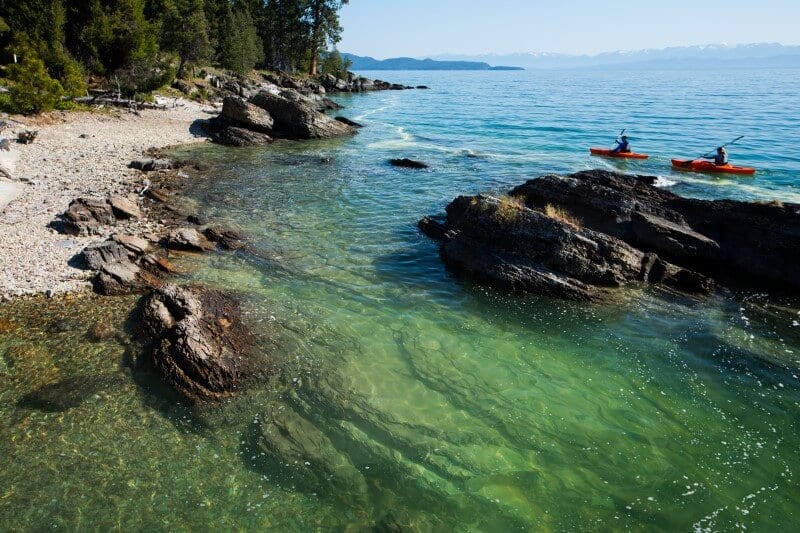 Credit: Visit Montana
Credit: Visit Montana
At over 2,100 acres, Wild Horse Island State Park is the largest island in the largest freshwater lake west of the Mississippi.
It is situated on Flathead Lake and abounds in opportunity for hiking, fishing, swimming, and kayaking.
Wild Horse Island has been a landmark since the Salish-Kootenai Indians were reported to have used it to pasture horses to keep them from being stolen by other tribes. Wild horses can still be seen on the island, although in very small numbers.
One is all you need to place you in a spirit of wonder!
The island is known for more than just horses; bighorn sheep, mule deer, songbirds, waterfowl, bald eagles and falcons make Wild Horse Island a great place in Montana for wildlife viewing.
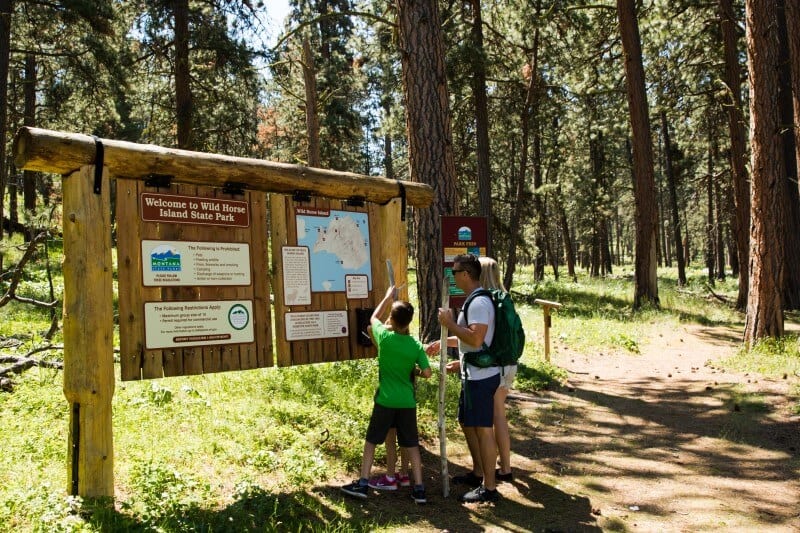 Credit: Visit Montana
Credit: Visit Montana
The island is for day-use only and maintains about 4 miles of trails, aptly named Trail 1 and Trail 2. You can combine them both in one loop trail which takes about 1 hour 20 minutes to do and has an elevation gain of 107 meters, making it a reasonably easy hike and a good one for beginners.
Follow the trail to the top of the island for a picnic in a hidden caldera-like formation.
Walk up to the rim for a stunning 360-degree view of Flathead Lake, Polson, Bigfork, Lakeside, Kalispell, and on a clear day, even Whitefish and Glacier National Park!
To visit Wild Horse Island on Flathead Lake, you will need a boat to access this primitive state park, or you can kayak or paddleboard over to the island (about 45 minutes.) Sea Me Paddle offers guided kayak trips to the island.
Lewis and Clark Caverns State Park
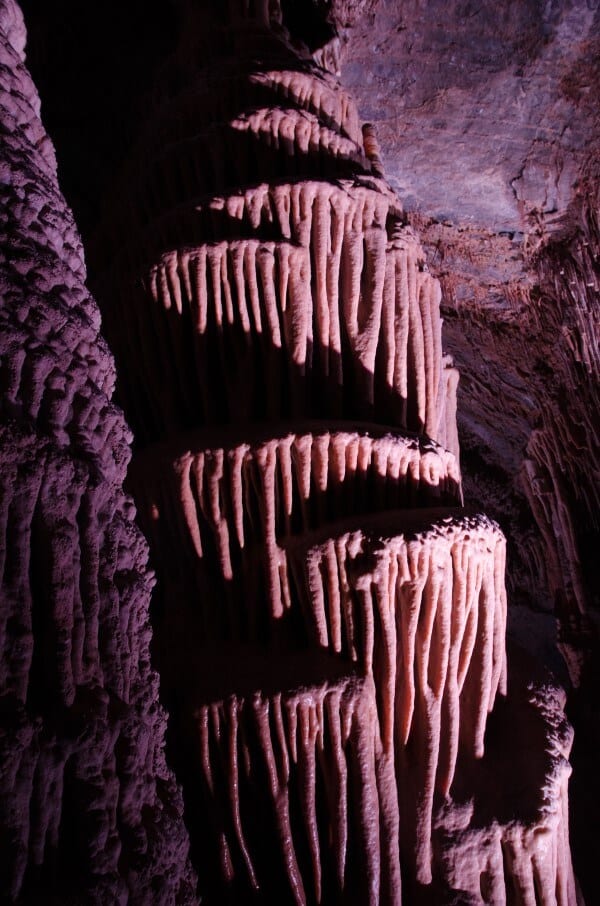 Credit: Visit Montana
Credit: Visit Montana
When you visit Montana, you will spend a lot of time looking at mountains and hiking up them. Now it’s time to explore the belly of the mountains at Lewis & Clark Caverns State Park.
Montana’s first and best-known State Park showcases one of the most highly decorated limestone caverns in the Northwest—President Theodore Roosevelt even designated Lewis & Clark Caverns State Park a National Monument on the same day as the Grand Canyon.
It was named to honor the famous explorers who crossed the park property, although they did not discover the caverns.
The impressive geological features of these Montana caverns include stalactites, stalagmites, and columns. The only way to see the caverns are by guided tours of the cave.
These tours range from easy to adventurous and some even cater to those with physical limitations. Bring a sweater, as the caves are naturally cool year-round.
The kids will love the two-hour Classic Tour with its stalactites and stalagmites, the famous Beaver Slide and occasional bat sightings.
The adventurous will love the Wild Cave Tour, where you can explore the caverns with only headlamps. Be prepared for a lot of bending, crawling and duck waddling.
The cave tour includes a short hike through gorgeous mountain scenery from the visitor’s center and back. This short hike is only about 2 km and takes 45 minutes to complete.
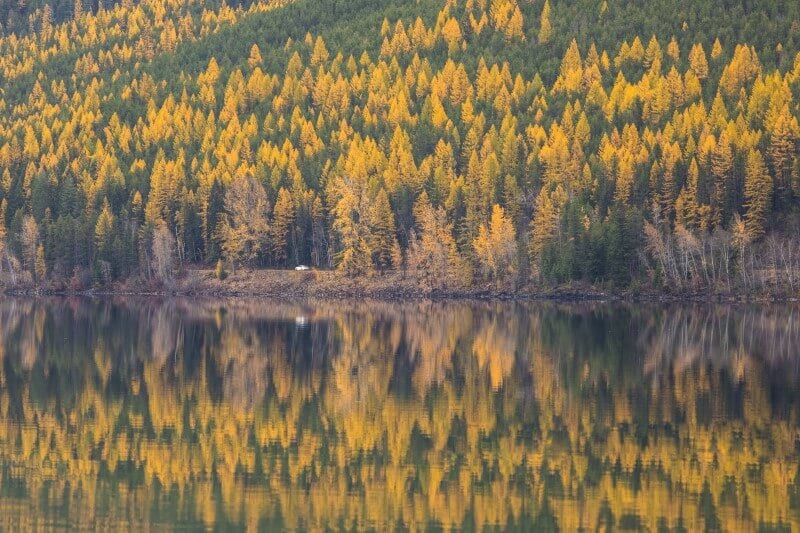 Credit: Visit Montana
Credit: Visit Montana
However, if you want a longer hike, there is a beautiful 10km loop hike called the Danmore Gypsum Mine, Middle View and Eastside Trail Loop trail, which takes you around the 3,000 acre park above ground. Here you’ll find plenty of opportunities for camping, hiking and biking.
More than half of the trails are naturally carved by the hooves of deer, elk and even the occasional mountain goat.
The trails are well-marked and maintained, and lead through remarkable changes in habitat, and runs between the camp’s two visitor centers and gives a good overview of the park.
The park has a large campground with 40 campsites, a tipi, and three cabins.
Custer Gallatin National Forest

Custer Gallatin National Forest is a huge landscape encompassing 3 million acres in Montana and a small portion in South Dakota.
It features six mountain ranges, including the Absaroka and Beartooth ranges, and is also home to Granite Peak, Montana’s highest point.
A highlight of the forest is Grasshopper Glacier, which is unique in that it’s embedded with thousands of fossilised grasshoppers and locusts.
Historically, the forest was established in 1899 but it later merged with the Custer National Forest in 2014.
Lava Lake Loop Hike
 Gallatin Gateway
Gallatin Gateway
The most popular hike Custer Gallatin National Forest is the Lava Lake Loop hike, which is a stunning8.7-km out-and-back trail near the Gallatin Gateway in Montana.
It’s a moderate trail which takes around 3.5 hours to complete and has an elevation gain of 504 meters. The trail is also shared with horseback riders, so look out for horses on the route.
The trail starts with a climb to a beautiful lake, which is framed by a backdrop of the craggy Spanish Peaks, before entering Cascade Creek Canyon.
After traversing through this Gallatin canyon, you hike on to Lava Lake. The trail passes through a really fragrant lodgepole forest, but opens after the canyon and has incredible lake and mountain vistas. Bring your camera for this one!
Bitterroot Valley

The Bitterroot Valley is located in western Montana and is known for its stunning, rugged landscape in the foothills of the Bitterroot Mountains to the west and the Sapphire Mountains to the east.
Flanked by pine forests and rolling alpine meadows sloping down the mountain sides, with the meandering Bitterroot River flowing through its heart, it’s well known for its breathtaking scenery.
Bass Creek Trail
The Bass Creek trail is a challenging 25.7 km hike from Stevensville, Montana through the Bitterroot National Forest.
This 8 hour hike is one of the lesser known hikes in Montana and offers plenty of solitude under the lush canopies of the pine forest, with fragrant needles dropping on your head as you hike in the Autumn sun.
It begins in the parking lot by Larry Creek Road or the Charles Waters Memorial Campground and ends at Bass Lake. Don’t miss a chance to turn around and admire views of the Bitterroot River at the start of this trail.
There are some stream crossings, steep sections, and rocky terrain throughout, so sturdy footwear is recommended.
Anaconda Pintler Wilderness Area
 Georgetown Lake
Georgetown Lake
The Anaconda-Pintler Wilderness Area is located in the southwest section of Montana and is known for its rugged and diverse landscapes.
It combines the Anaconda and Pintler mountain ranges, known for their dramatic peaks, alpine lakes, and dense forests of Douglas fir and lodgepole pine.
The “Pintlers,” as it’s known by the locals, are also famed for their colorful rock formations, which were shaped by glaciation, leaving behind U-shaped valleys and moraines.
Later in history, it was shaped by mining activity, particularly for copper. It became a designated wilderness area in 1964.
Tamarack Lake

The Tamaracks is a 22.5-km out-and-back trail near Philipsburg, which is considered a challenging route.
It takes around 7 hours to complete and has an elevation gain of 796 meters, making it one of the higher elevations on this list.
It you love a challenge, you will love this hike, surrounded by snow-capped mountains, tall pine forests, and fresh water lakes.
Best Times To Go Hiking In Montana
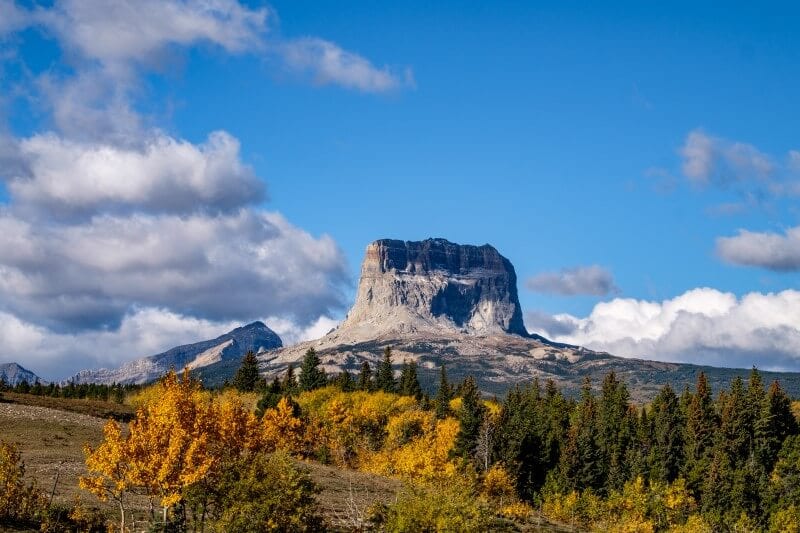 Chief Mountain in Glacier National Park in the fall. Credit: Visit Montana
Chief Mountain in Glacier National Park in the fall. Credit: Visit Montana
You might be wondering when are the best times to go hiking in Montana and if Fall is the right season for it.
Fall runs from the mid-September until mid-December, and is one of the best seasons to go hiking, particularly in Montana. This is because it’s right before the hibernation season so wildlife is quite active as they get prepared for the winter.
In the Spring, you get lovely weather, but the animals have just woken up and they are hungry.
The best time for animal viewing is from the end of October to the end of November, as this is when animals are active.
However, you will find better weather for hiking from the end of September, as in late September it’s still sunny but temperatures have cooled, making it easier conditions for hiking.
Note that Labor Day, Veterans Day, and Thanksgiving, are all public holidays in the Fall and these weekends will be busy for hikers.
Related Reading
Need more inspiration for visiting Montana and going on road trips? Here are some other useful guides…
Pin To Save On Pinterest
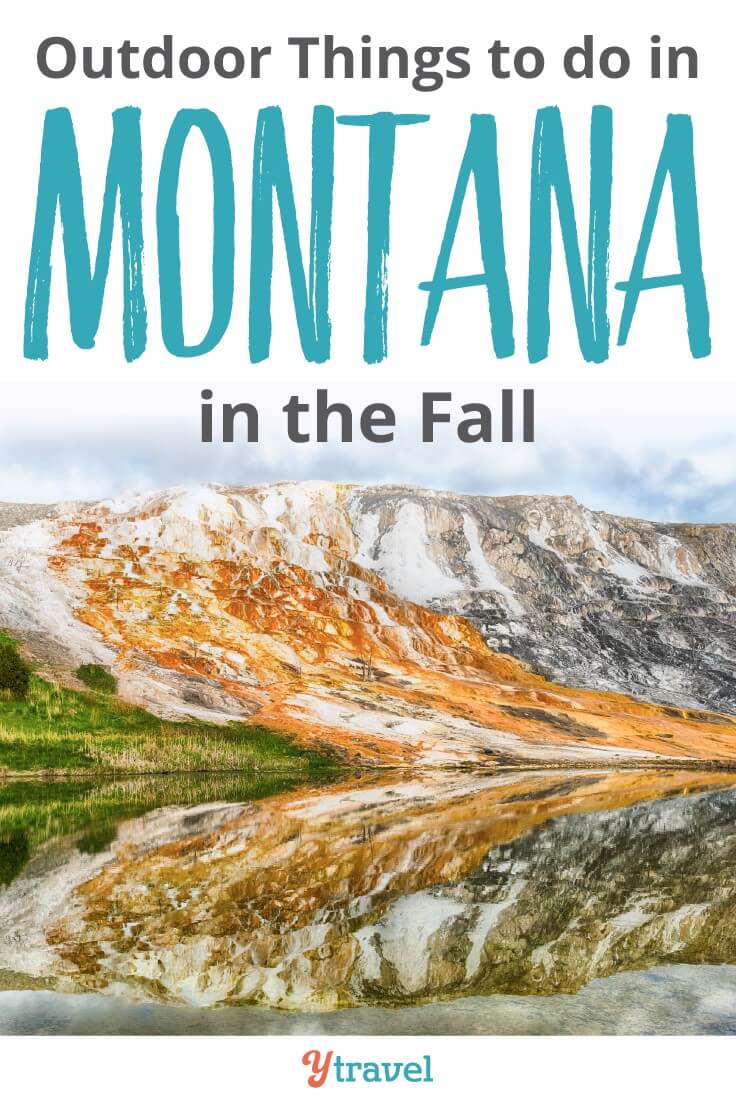
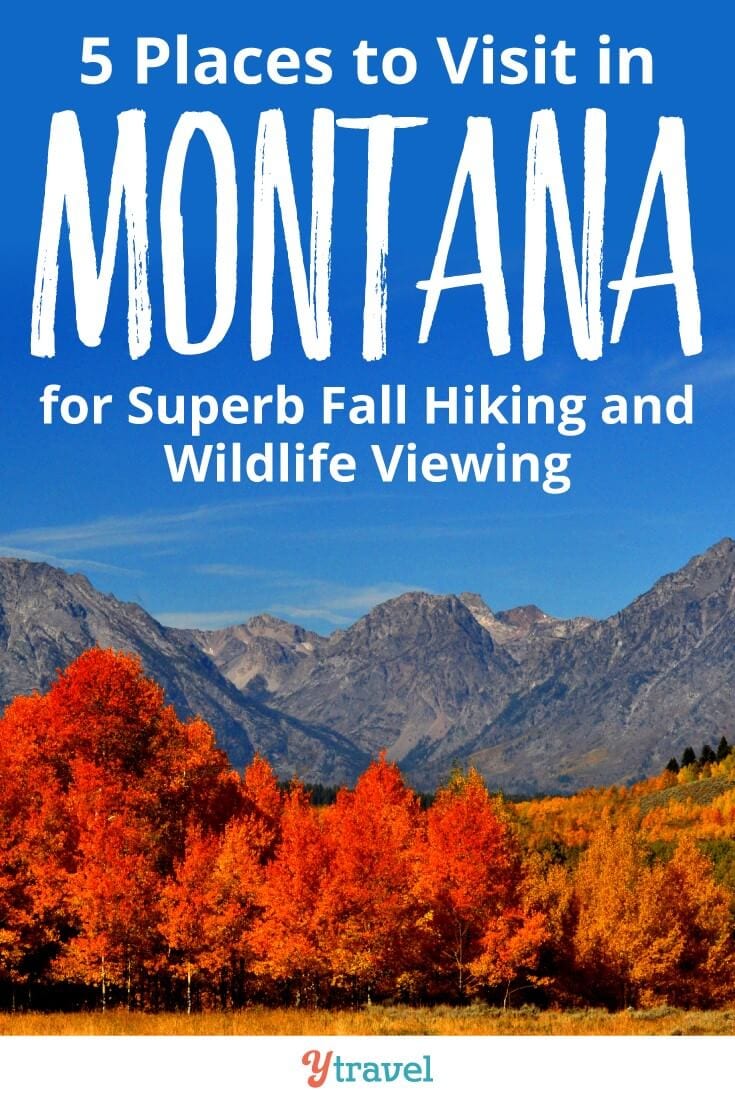
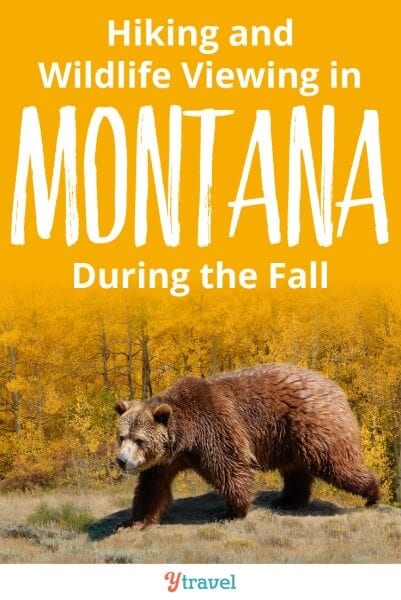
Which of these places in Montana would you like to go for wildlife viewing? Let us know in the comments.
Източник за тази статия
Наши спонсори са:
Български трактори на добри цени при изключително качество






